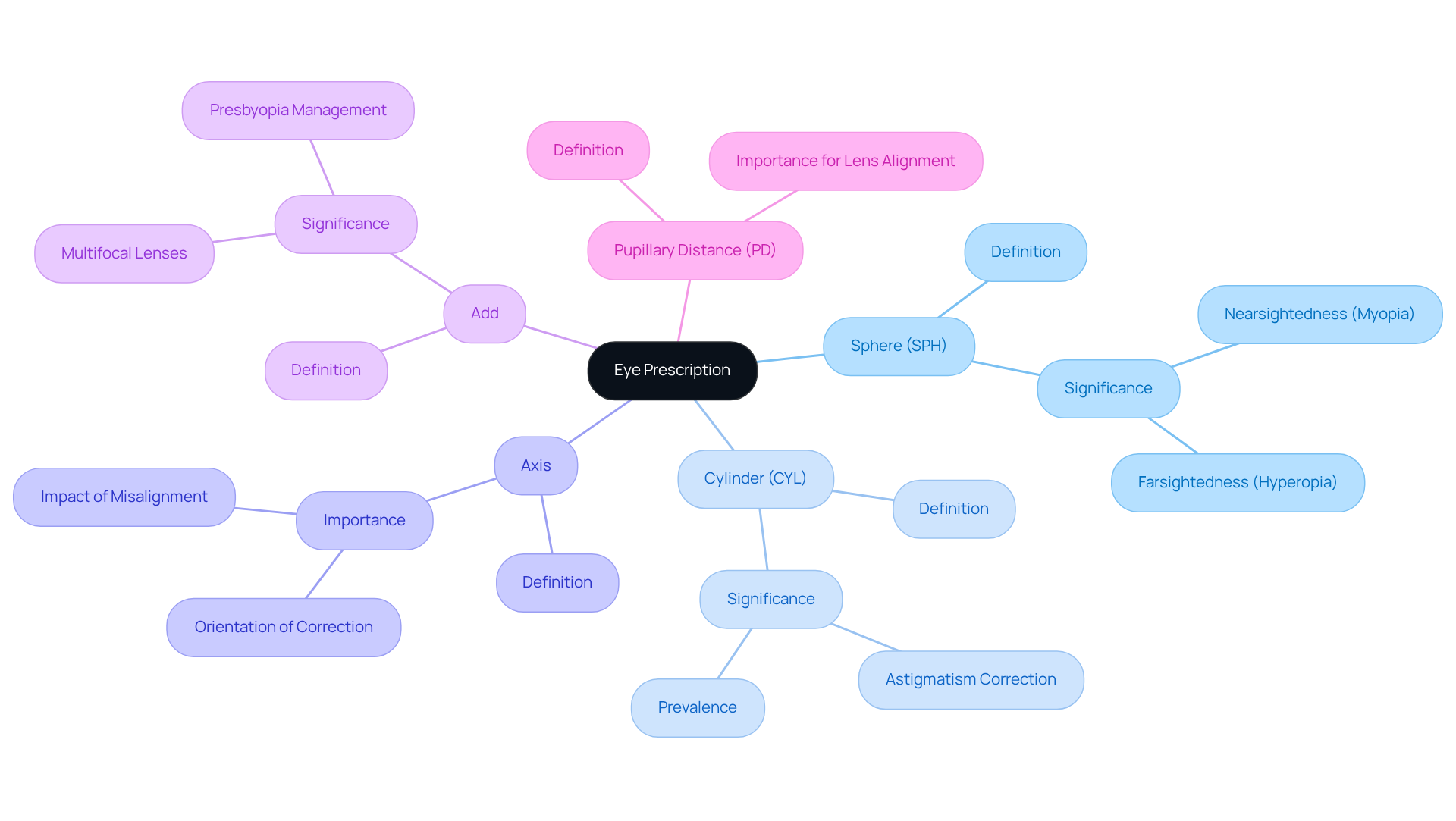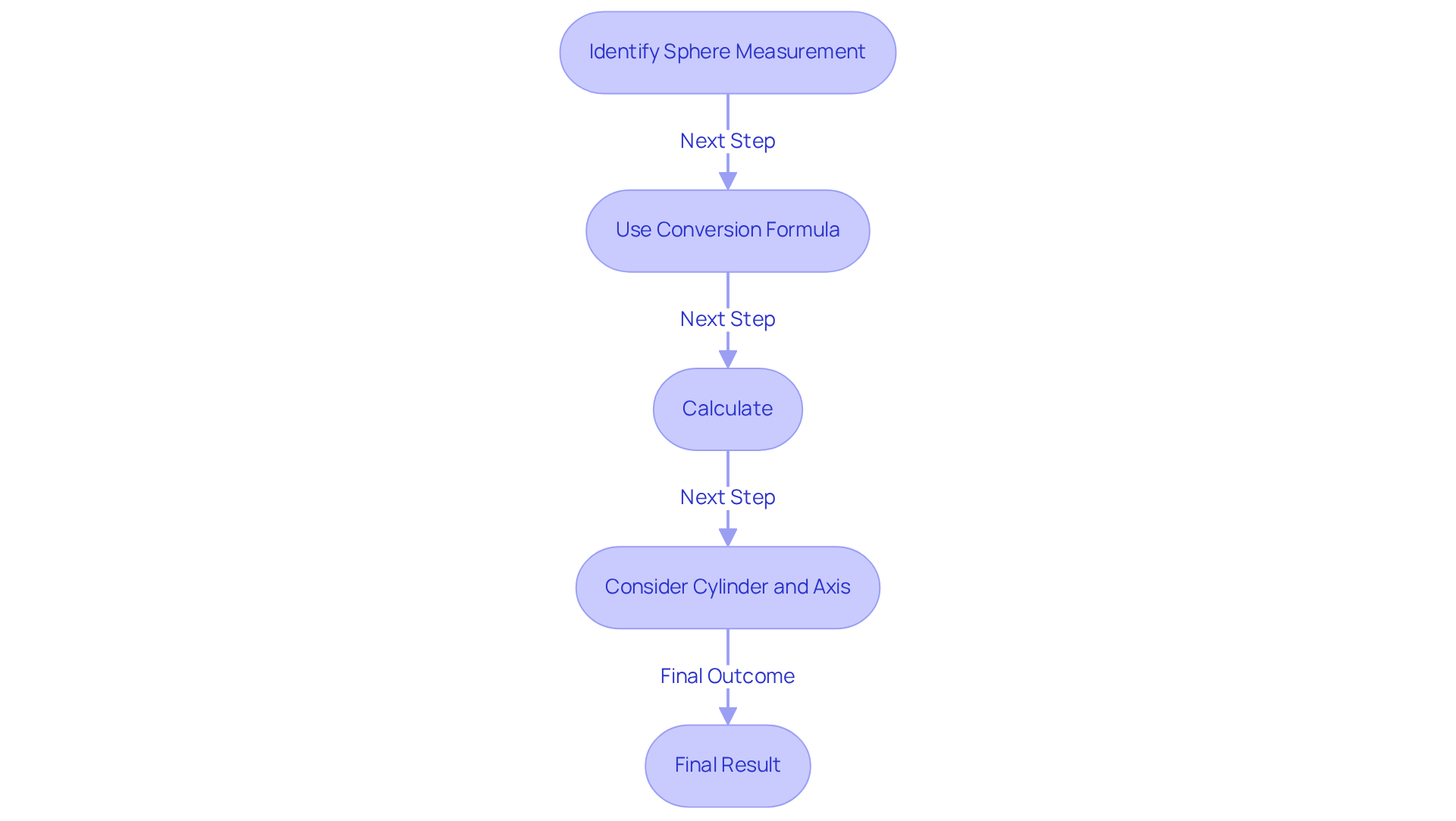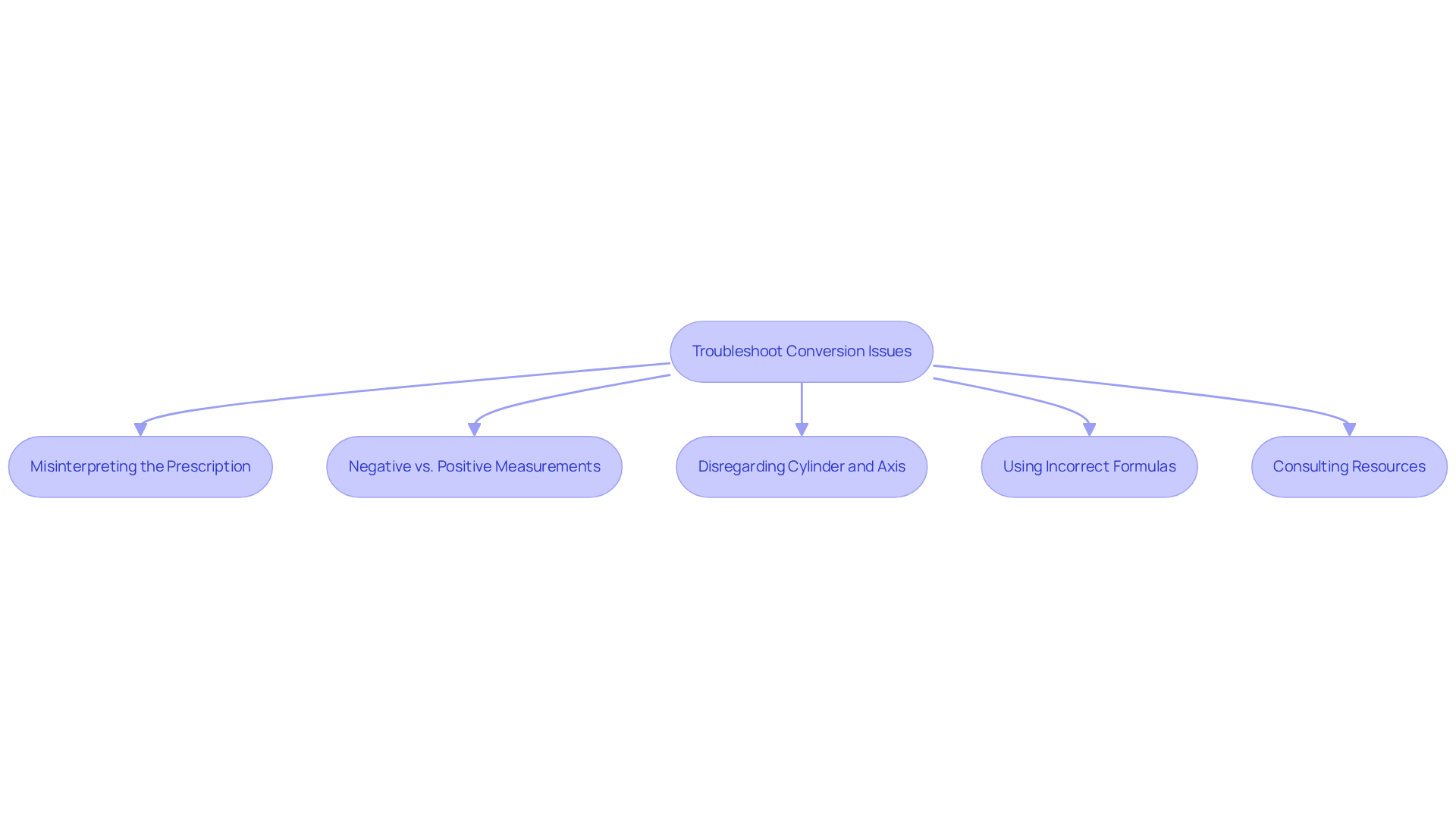Posted by: Northwest Eye in General on August 20, 2025
Overview
This article offers a compassionate step-by-step guide on converting an eye prescription into the 20/20 scale. We understand that navigating your prescription can be overwhelming, so we emphasize the importance of grasping key components like sphere (SPH), cylinder (CYL), and axis measurements. To support you in this process, we outline specific formulas for conversion and address common issues that may arise. Our goal is to ensure you can accurately interpret your prescriptions and achieve optimal vision correction, empowering you on your journey to better sight.
Introduction
Understanding an eye prescription can indeed feel perplexing, often filled with technical jargon that leaves many feeling lost. We understand that this essential document is crucial for achieving optimal vision health, as it outlines critical components like sphere, cylinder, and axis values. By demystifying the conversion process to the 20/20 scale, you can gain clarity on your visual acuity and make informed decisions regarding your eye care. Yet, it’s common to feel uncertain when misconceptions and calculation errors threaten to obscure this vital information.
Understand Your Eye Prescription
To begin, we understand that locating your eye prescription can feel overwhelming. This important document, typically provided by your eye care professional, includes several key components that are essential for your vision health:
- Sphere (SPH): This signifies the lens power required to rectify nearsightedness (indicated by a negative figure) or farsightedness (indicated by a positive figure). For instance, a measurement of -2.00 indicates moderate nearsightedness. It’s crucial to understand SPH, as it directly affects how well you can see at different distances.
- Cylinder (CYL): This measurement corrects astigmatism and is also expressed in diopters. A negative value indicates a specific type of astigmatism, which affects how light is focused on the retina. It’s important to note that roughly 1 in 3 individuals encounter astigmatism, making this element essential for clear sight.
- Axis: This number, ranging from 1 to 180, indicates the orientation of astigmatism correction. Understanding the axis is vital for ensuring that are correctly aligned, as misalignment can cause discomfort and inadequate correction of sight.
- Add: This represents the additional power needed for multifocal lenses, typically for reading. Understanding the Add value is particularly important for those over 40, as it helps in managing presbyopia, a common age-related vision change.
Additionally, it’s comforting to know that you are legally entitled to a copy of your eye assessment, as stated by the Federal Trade Commission. This guarantees that you can obtain your medication without the pressure of having to buy eyewear from your eye doctor’s office.
Research shows that a considerable percentage of patients misinterpret their eye orders, which can lead to improper eyewear selections. Therefore, understanding these components is essential for the next steps in how to convert your order using the convert eye prescription to 20/20 scale calculator. By familiarizing yourself with these terms, including the importance of pupillary distance (PD) for proper lens alignment, you empower yourself to make informed decisions about your eye care. Remember, we are here to help you through this process.

Convert Your Prescription to 20/20 Scale
To convert eye prescription to 20/20 scale calculator, we understand that this process may feel a bit daunting. However, with a few simple steps, you can gain clarity about your vision.
- Identify the Sphere Measurement: Start with the SPH figure from your prescription. If it’s negative, it indicates nearsightedness, which is quite common.
- Use a Conversion Formula: The general formula to estimate visual acuity from diopters is:
- For nearsightedness: 20/(20 – (SPH * 20))
- For farsightedness: 20/(20 + (SPH * 20))
- Calculate: Insert your SPH number into the formula. For example, if your SPH is -2.00:
- 20/(20 – (-2.00 * 20)) = 20/100. This means you see at 20 feet what a person with normal vision sees at 100 feet.
- Consider Cylinder and Axis: If you possess a CYL quantity, it may slightly alter your final visual acuity. Generally, for simple conversions, focus primarily on the SPH value.
To achieve clarity in vision, one can use a tool to convert eye prescription to 20/20 scale calculator. Final Result: The outcome will provide you with an estimation of your sight, which you can obtain by using a convert eye prescription to 20/20 scale calculator.
Comprehending these conversions is essential, as a convert eye prescription to 20/20 scale calculator is a common technique employed to anticipate eye requirements and track the advancement of eye conditions. It’s common to feel uncertain about these measurements, but rest assured that many individuals can read as small as 20/10, showcasing the range of visual acuity levels.
Optometrists emphasize the importance of the SPH value in determining the best corrected visual acuity, which is often around 20/20 for many individuals. As Vasudha Rao states, “Oftentimes the best corrected visual acuity is 20/20.” Recent advancements in eye evaluation conversion techniques continue to enhance accuracy, ensuring patients receive the most precise assessments of their vision. Additionally, the method of refraction is the preferred technique for determining best corrected visual acuity, further underscoring the importance of understanding these conversions.
We are here to , ensuring you feel supported every step of the way.

Troubleshoot Common Conversion Issues
When converting your eye prescription to the 20/20 scale, we understand that you may encounter several common issues that can lead to misunderstandings:
- Misinterpreting the Prescription: It’s essential to correctly recognize the SPH (sphere), CYL (cylinder), and Axis measurements. If you’re uncertain, please don’t hesitate to double-check with your eye care provider. We are here to help you through this process.
- Negative vs. Positive Measurements: Negative figures indicate nearsightedness (myopia), while positive figures signify farsightedness (hyperopia). Misinterpreting these can lead to incorrect conversions, impacting your sight correction. It’s common to feel confused by these terms, but understanding them is crucial.
- Disregarding Cylinder and Axis: For individuals with astigmatism, the CYL and Axis values are essential for a thorough comprehension of your sight requirements. Although they may not directly convert eye prescription to 20/20 scale calculator, they play a significant role in your overall vision correction. As mentioned by the American Optometric Association, age can influence alterations in eyeglass requirements, especially in the early to mid-40s. Recognizing these elements is vital for your eye health.
- Using Incorrect Formulas: Ensure that you are applying the . If you’re unsure, consulting with an eye care professional can provide clarity and guidance. We want to ensure you feel confident in your understanding.
- Consulting Resources: If difficulties persist, consider utilizing online calculators or seeking assistance from your eye care provider to better understand your eyewear details and the conversion process. The AOA offers resources that can help clarify these aspects.
Data suggest that almost 40% of patients misunderstand their eye prescriptions, resulting in possible problems with their correction. Frequent errors involve neglecting the significance of cylinder and axis values, which can lead to insufficient correction and discomfort. Eye care professionals emphasize the importance of understanding these components to avoid complications. By addressing these common pitfalls, you can ensure a more accurate conversion when you use a convert eye prescription to 20/20 scale calculator and achieve a clearer understanding of your vision needs. Remember, we are here to support you every step of the way.

Conclusion
Understanding how to convert an eye prescription to the 20/20 scale is crucial for anyone seeking clarity about their vision. We recognize that navigating the components of an eye prescription—sphere, cylinder, axis, and add values—can feel overwhelming. By demystifying these elements, you can make informed decisions about your eye care. This knowledge empowers you to accurately assess your visual acuity and determine the best corrective measures needed for optimal sight.
Throughout this article, we’ve shared key insights on the significance of each aspect of an eye prescription, along with a straightforward step-by-step guide to performing the conversion. We understand that common pitfalls, such as misinterpreting prescription values or using incorrect formulas, can lead to confusion. By familiarizing yourself with these elements, you can enhance your understanding of your vision needs and avoid the uncertainty that often accompanies eye prescriptions.
Ultimately, taking charge of your eye health is essential. By utilizing the conversion tools available and consulting with eye care professionals when needed, you can achieve a clearer understanding of your vision requirements. Embracing this knowledge not only aids in selecting the right eyewear but also fosters a proactive approach to maintaining your eye health. Remember, clarity in vision begins with understanding your prescription; take the necessary steps today to ensure your sight is as sharp as it can be.
Frequently Asked Questions
What is an eye prescription?
An eye prescription is a document provided by your eye care professional that includes key components necessary for your vision health, such as Sphere (SPH), Cylinder (CYL), Axis, and Add.
What does Sphere (SPH) indicate in an eye prescription?
Sphere (SPH) signifies the lens power required to correct nearsightedness (negative figure) or farsightedness (positive figure). For example, a measurement of -2.00 indicates moderate nearsightedness.
What is the purpose of Cylinder (CYL) in an eye prescription?
Cylinder (CYL) measures the lens power needed to correct astigmatism, expressed in diopters. A negative value indicates a specific type of astigmatism, which affects how light focuses on the retina.
How is the Axis value important in an eye prescription?
The Axis value, ranging from 1 to 180, indicates the orientation of astigmatism correction. It is vital for ensuring that corrective lenses are properly aligned to avoid discomfort and inadequate vision correction.
What does the Add value represent in an eye prescription?
The Add value represents the additional power needed for multifocal lenses, typically for reading. It is particularly important for individuals over 40, as it helps manage presbyopia, an age-related vision change.
Am I entitled to a copy of my eye assessment?
Yes, you are legally entitled to a copy of your eye assessment according to the Federal Trade Commission, allowing you to obtain your medication without being pressured to purchase eyewear from your eye doctor’s office.
Why is it important to understand my eye prescription?
Understanding your eye prescription is essential to avoid misinterpreting your eye orders, which can lead to improper eyewear selections. Familiarity with terms like pupillary distance (PD) helps ensure proper lens alignment and informed decisions about your eye care.






